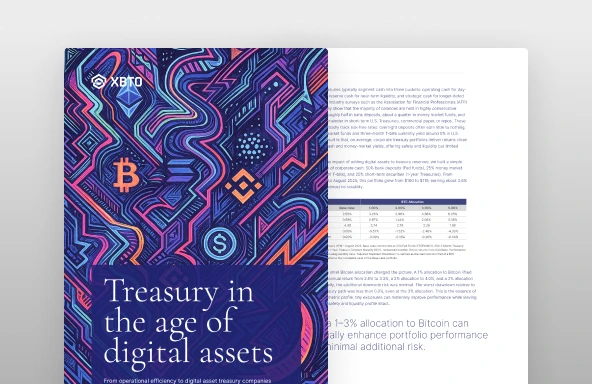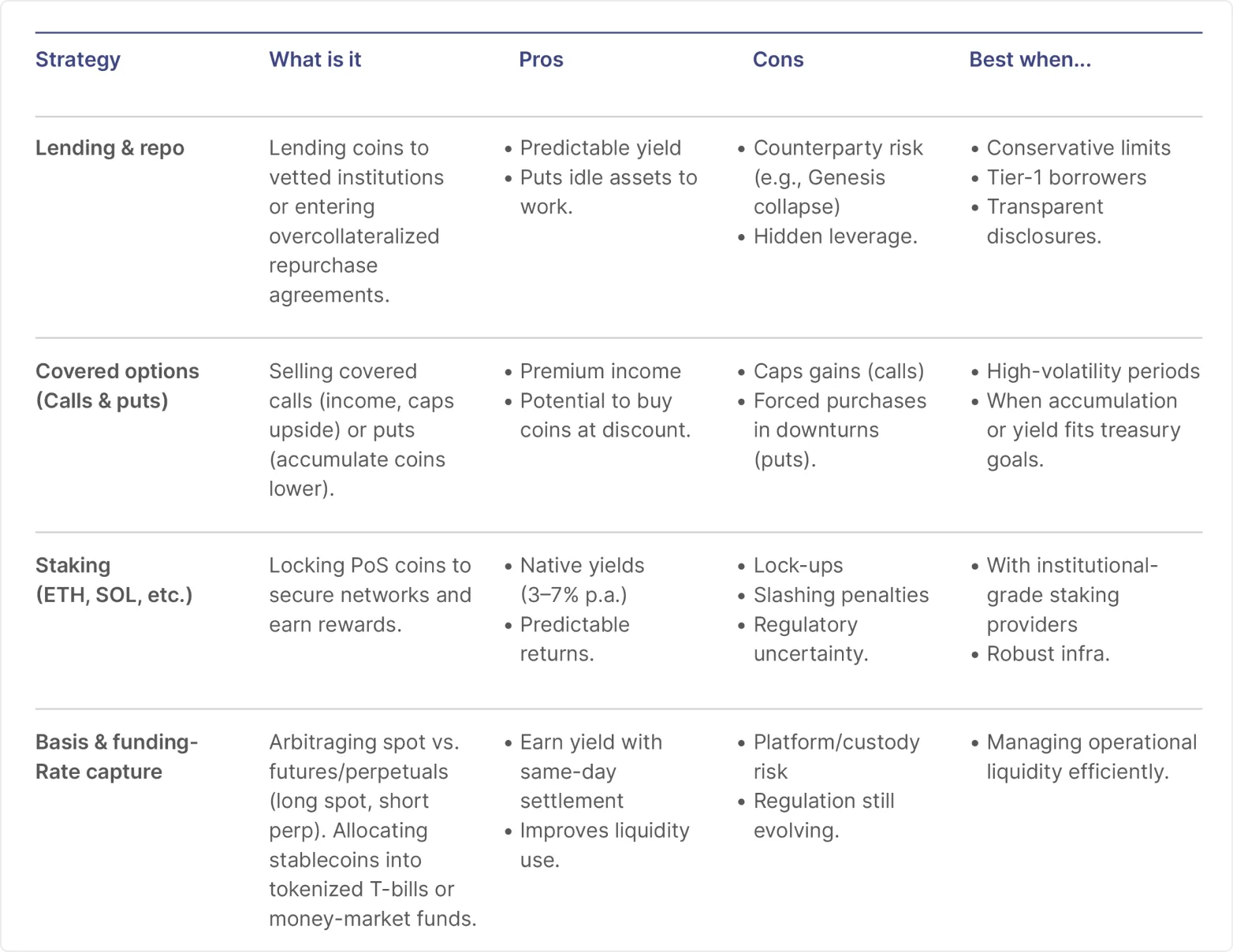

Crypto treasury management: How digital assets are redefining corporate finance. | AI generated image by XBTO
Crypto treasury management: How digital assets are redefining corporate finance. | AI generated image by XBTO
Against this backdrop, a new class of Digital Asset Treasury Companies (DATCOs) and a crypto treasury management have emerged as a pragmatic toolkit to address these constraints. It involves the disciplined use of digital assets, such as stablecoins and tokenized securities, to enhance efficiency, resilience, and returns across the balance sheet.
For modern treasurers, digital assets are rapidly shifting from being an experimental consideration to becoming essential operational enhancements. The question is no longer if they matter, but how to use them wisely.
The evolution of corporate treasury: From gold reserves to digital assets
The mission of treasury has always been clear:
- Preserve value.
- Ensure liquidity.
- Deploy capital efficiently.
The tools used by corporate treasurers have always evolved to reflect the financial architecture of the era. Companies once held gold reserves to hedge against monetary instability, and later relied on commercial paper and derivatives to fine-tune liquidity. For decades, the primary toolkit consisted of bank deposits, short-term government securities, and conventional hedging instruments.
Today, however, that familiar toolkit is showing its limits, particularly in a global economy that moves at digital speed. What’s changed is the operating environment. Inflation, interest-rate volatility, and fragmented payment networks have strained legacy systems. Cross-border wires still take days and cost percentages of the transaction. Idle cash in bank accounts earns near-zero returns, even as shareholders demand efficiency.
Digital asset treasury practices provide modern solutions where traditional finance falls short.
- Stablecoins enable global money movement in minutes, rather than days.
- Tokenized securities offer cash-equivalent liquidity with competitive yields, addressing the chronic problem of cash drag.
- Furthermore, scarce, non-sovereign digital assets like Bitcoin introduce a reserve option that can materially hedge against monetary uncertainty and improve overall capital efficiency, even in small allocations.
Digital assets are extending the treasury's mandate into a world of instant settlement, asymmetric returns, and resilient reserves.
What is crypto treasury management?
At its core, crypto treasury management integrates blockchain-based instruments directly into operational and strategic financial planning. This involves three primary classes of tools: stablecoins for payments, tokenized securities for cash management, and strategic digital reserves.
Stablecoins are foundational to modern corporate crypto treasury operations, acting as digital cash that enables near-instant settlement with minimal fees. Unlike traditional international wire transfers, which can take 1–5 business days and incur fees ranging from $25–$50, stablecoins solve an old problem: speed and predictability.
- Settlement time: minutes instead of days.
- Cost: under $1 per transaction, often without FX markups.
- Availability: 24/7/365.
This immediacy is critical for shrinking the cash-conversion cycle. A global marketplace, for instance, can instantly pay thousands of suppliers upon delivery instead of waiting days for clearing, thus shrinking Days Sales Outstanding (DSO) and freeing up working capital. Treasurers also benefit from programmable settlement rules and automated reconciliation provided by on-chain rails, offering a level of audit granularity unmatched by legacy bank statements.
The perennial treasury problem is "cash drag": excess cash parked in bank accounts yielding little or nothing, sometimes as low as 0.5%. The advent of tokenized treasuries provides an elegant solution. These instruments, such as tokenized T-bills or regulated stablecoins backed by short-term government debt, behave as digital cash equivalents.
Platforms like BlackRock’s BUIDL and Franklin Templeton’s BENJI offer same-day liquidity and daily redemption, meaning idle cash can be instantly swept into yield-bearing assets. They provide yields directly aligned with money market rates (currently yielding around 5% in U.S. dollars in 2025). Programmable treasury management even allows firms to automate intraday sweeps between stablecoins for working capital and tokenized T-bills for yield, creating a just-in-time inventory system for capital.
Beyond operational efficiency, some treasurers are exploring strategic reserves by allocating small portions to assets like Bitcoin, which have a finite supply and an asymmetric return profile. With fiat reserves exposed to monetary expansion and fiscal deficits, these assets offer a structural counterbalance. Crucially, analysis of performance from January 2019 to August 2025 shows that adding even a 1–3% Bitcoin allocation can materially enhance overall portfolio performance, lifting annualized returns from 2.6% (Base Case) to 4.7% (3% BTC allocation). This improvement comes with minimal additional downside risk, demonstrating the asset’s ability to improve capital efficiency while preserving core liquidity.
From Bitcoin holdings to DATCOs: Shift from passive to active digital treasury
The modern story of the corporate crypto treasury shifted profoundly with the emergence of the Digital Asset Treasury Company, or DATCO. What began as MicroStrategy’s initial, largely passive strategy of converting its balance sheet reserves into Bitcoin in August 2020 quickly evolved into a new corporate archetype. These are publicly traded entities whose primary business is their digital asset balance sheet.
By August 2025, over 180 publicly listed companies and more than 60 privately held firms globally reported holding Bitcoin, collectively controlling over one million BTC (about 5% of the total supply).
The DATCO model exists due to a convergence of three key forces:
- Investor Access (The Wrapper): Many institutions and retail savers prefer owning a familiar equity wrapper rather than navigating direct digital asset ownership, exchanges, and wallets. The DATCO stock acts as a convenient vehicle, which often explains why these equities trade at a premium to their underlying holdings.
- Capital-Markets Alchemy: These companies utilize the premium in their stock price to raise capital (often through convertible bonds or equity issuance) and efficiently acquire more coins, increasing the Bitcoin-per-share for existing investors. This creates a powerful flywheel of accumulation in rising markets.
- Management as Alpha: Investors are not just buying asset exposure; they are betting on management's expertise to finance prudently, execute large acquisitions without market slippage, safeguard holdings with robust custody, and generate yield.
While Bitcoin remains the anchor, the model is diversifying. Companies are increasingly holding Ethereum (ETH) and Solana (SOL). For instance, public companies collectively held over 3 million ETH by September 2025, attracted by Ethereum’s yield-bearing nature through staking. Corporate SOL holdings have also surged in 2025, leveraging its low-fee environment and speed.
Use cases: Efficiency, yield, and institutional advantage
The practical application of digital assets delivers tangible benefits across key treasury functions, focusing intensely on efficiency and capital deployment.
Stablecoin payments fundamentally restructure how multinational companies handle global commerce. The traditional correspondent banking friction - slow wires, unpredictable fees, and cash float -is nearly eliminated. Stablecoins offer transparent costs and settlement in minutes, making them highly appealing alternatives for treasury operations. This ability to settle instantly, 24/7, allows firms to improve working capital management and automate reconciliation processes through programmable settlement rules.
Tokenized treasuries combat cash drag by instantly mobilizing previously idle balances. Instead of earning less than 1% in bank accounts, surplus cash can be swept into tokenized U.S. Treasury bills yielding over 5%. Furthermore, updated accounting standards (such as FASB’s 2025 update) allow these tokenized T-bills to be classified as cash equivalents, enabling transparent fair value reporting. This simplifies workflows and enhances cross-border liquidity management, especially where MiCAR-compliant stablecoins or tokenized T-bills are treated as cash equivalents under IFRS.
Digital asset treasury instruments facilitate the programmatic optimization of liquidity. Treasurers can automate intraday sweeps, instantly shifting surplus cash into yield-bearing assets and drawing it back into stablecoins when working capital needs arise.
Tokenization also opens new avenues for funding the balance sheet itself. Companies can issue debt, equity, or hybrid instruments directly on-chain, reducing settlement friction, widening the investor base, and lowering issuance costs compared to traditional underwriting. Case studies, such as Siemens issuing a €60 million bond directly on the Polygon blockchain, demonstrate settlement in two days versus a week or more traditionally.
Even small allocations to Bitcoin or Ethereum can strengthen balance-sheet resilience. Their finite supply and global liquidity make them complementary to fiat reserves, especially in markets exposed to inflation or capital controls.
Risk & governance in crypto treasury management
Integrating digital assets demands institutional rigor in risk management and governance. For CFOs and treasurers, confidence relies on robust structures around custody, compliance, and counterparty risk.
Safeguarding digital assets is paramount, and strong custody practices act as a key differentiator for institutional adoption. Reputable digital asset treasuries utilize institutional-grade custodians (like Coinbase Custody or Fidelity Digital Assets), implementing cold storage and multi-signature controls to minimize hack risk. Using regulated custodians, often operating under standards like NYDFS oversight, ensures assets are secured in audited environments, reducing the operational risks associated with self-custody.
Recent regulatory and accounting shifts have significantly improved the transparency required for crypto treasury management. The FASB’s 2025 update allows Bitcoin and certain cryptocurrencies to be marked at fair value, replacing previous impairment-only rules. This provides timely and transparent asset reporting. Similarly, well-designed programs allow regulated stablecoins and tokenized T-bills to be classified as cash equivalents under criteria like IFRS or EU MiCAR rules, simplifying cross-jurisdictional liquidity management.
However, risks persist, particularly related to leverage and counterparty exposure. Firms relying on debt (like secured loans or convertible bonds) to purchase digital assets face threshold risk; a price drop can trigger forced collateral top-ups or liquidation. The collapse of firms like Genesis underscored the fragility of relying on untransparent credit channels. Prudent treasuries maintain conservative Loan-to-Value (LTV) ratios (ideally less than 25%) and select Tier-1 borrowers when employing yield strategies.
Portfolio role: Diversification, yield, and liquidity management
Digital assets play a strategic role in the corporate portfolio by simultaneously addressing diversification, yield generation, and liquidity needs.
Digital assets like Bitcoin offer a non-sovereign hedge against macro uncertainty, proving a valuable diversification tool. As demonstrated by performance analysis (January 2019 – August 2025), even small allocations to Bitcoin (1–3%) significantly improve the portfolio’s overall annualized return and capital efficiency without materially compromising safety or liquidity. This is the essence of the asymmetric return profile: tiny exposures can materially improve performance while leaving the safety profile intact.
Passive "buy and hold" strategies are becoming insufficient for justifying the high premiums often paid for DATCO stocks. Investors now expect active management to enhance capital efficiency. Treasuries are increasingly putting assets to work responsibly through structured yield strategies, including:
- Staking: Locking up Proof-of-Stake assets like Ethereum or Solana to secure the network and earn native yields, transforming treasury reserves into predictable income streams.
- Options Strategies: Monetizing the high implied volatility of digital assets (which is structurally 2–3x higher than equities) by selling covered calls for income or selling puts to acquire coins at a discount. Active options strategies have been shown to consistently secure better effective entry prices than simple spot purchases, creating a compounding advantage over time.
- Tokenized Money Markets: Allocating stablecoins into tokenized T-bills or money market funds to capture prevailing risk-free rates with same-day liquidity.
Well-designed digital asset treasury programs can enhance after-tax and accounting outcomes. In many jurisdictions, capital gains on assets like Bitcoin are taxed only upon disposal, granting a deferral advantage compared to the annual taxation of interest income from traditional T-bills. The shift to fair value accounting in the U.S. (2025) provides necessary transparency, while IFRS and MiCAR criteria facilitate the classification of regulated stablecoins and tokenized assets as cash equivalents across Europe.
The evolution of corporate finance toward crypto treasury management is irreversible; the technology paradigm has shifted, and treasuries must adapt to a world running on digital rails. Several trends point to the accelerating institutionalization of this space.
We are seeing a rapid expansion of tokenized assets beyond simple T-bills, extending into commercial paper, bonds, and other real-world assets (RWA). This tokenization reduces issuance costs, widens investor access, and allows for much more flexible capital formation. Future treasuries will be programmable, using smart contracts to automate risk limits, liquidity sweeps, and compliance checks in real time, turning the balance sheet into an active, intelligent system.
The cohort of DATCOs will continue to grow, but the focus will shift from simple accumulation to differentiation. To sustain investor premiums, these companies must prove they are skilled stewards of capital. Investors will increasingly scrutinize metrics like TNAV per share, Coins Per Share (CPS), and issuance efficiency, demanding proof that management is accretive and not simply diluting shareholders. The leaders will be those who finance responsibly (e.g., using low-cost zero-coupon convertible bonds) and execute acquisitions methodically using derivative-assisted strategies. For more insights into this evolution, see our in-depth analysis on digital asset corporate structures.
The treasury of tomorrow will be plural, not binary. It will blend fiat currencies for traditional obligations, stablecoins for global settlement, tokenized treasuries as programmable cash equivalents, and strategic digital reserves for macro hedging and optionality. This multipolarity enhances operational resilience by spreading risks across multiple settlement systems. This shift is supported by increasing institutional clarity and regulation [Source: RWA.xyz / Forbes / Fireblocks].
The corporate treasury is tasked with managing capital, and the latest chapter in that story is defined by digital assets. Crypto treasury management transforms the treasury department from a cost center into a strategic source of competitive advantage. By leveraging stablecoins for immediate global payments, utilizing tokenized treasuries to mobilize passive cash, and prudently allocating strategic reserves, corporations can achieve unprecedented efficiency and capital flexibility. This shift represents Treasury 2.0: a move toward a resilient, technologically agile, and actively managed balance sheet that is perfectly aligned with the demands of the digital economy.
The full breakdown
In our first article, "Navigating Crypto Volatility: The Advantages of Active Management," we explored how the high volatility and low correlation of digital assets with traditional asset classes create unique opportunities for active managers. We discussed how these characteristics enable active managers to execute tactical trading strategies, capitalizing on short-term price movements and market inefficiencies. Building on that foundation, we now turn our attention to the unique market microstructure of digital assets.
Conducive market microstructure of digital assets
The market microstructure of digital assets - a framework that defines how crypto trades are conducted, including order execution, price formation, and market interactions - sets the stage for active management to thrive. This unique ecosystem, characterized by its continuous trading hours, diverse trading venues, and substantial market liquidity, offers several advantages for active management, providing a fertile ground for sophisticated investment strategies.
24/7/365 market access
One of the defining characteristics of digital asset markets is their continuous, round-the-clock operation.
Unlike traditional financial markets that operate within specific hours, cryptocurrency markets are open 24 hours a day, seven days a week, all year round. This continuous trading capability is particularly advantageous for active managers for several reasons:
- Immediate response to market events: Unlike traditional markets that close after regular trading hours, digital asset markets allow managers to react immediately to breaking news or events that could impact asset prices. For instance, if a significant economic policy change occurs over the weekend, managers can adjust their positions in real-time without waiting for markets to open.
- Managing volatility: Continuous trading provides more opportunities to capitalize on price movements and volatility. Active managers can take advantage of this by implementing strategies such as short-term trading or hedging to mitigate risks and lock in gains whenever market conditions change. For instance, if there’s a sudden drop in the price of Bitcoin, managers can quickly sell their holdings to minimize losses or buy in to capitalize on the lower prices.
Variety of trading venues
The proliferation and variety of trading venues is another crucial element of the digital asset market structure. The extensive landscape of over 200 centralized exchanges (CEX) and more than 500 decentralized exchanges (DEX) offers a wide array of platforms for cryptocurrency trading. This diversity is beneficial for active managers in several ways:
- Risk management and diversification: By spreading trades across various exchanges, active managers can mitigate counterparty risk associated with any single platform. Additionally, the ability to trade on both CEX and DEX platforms allows managers to diversify their strategies, incorporating different levels of decentralization, regulatory environments, and security features.
- Arbitrage opportunities: Different venues often exhibit price discrepancies, presenting arbitrage opportunities. For example, managers can buy an asset on one exchange at a lower price and sell it on another where the price is higher, thus generating risk-free profits.
- Access to diverse liquidity pools: Multiple trading venues provide access to diverse liquidity pools, ensuring that managers can execute large trades without significantly impacting the market price.
Spot and derivatives markets (Variety of instruments)
The seamless integration of spot and derivatives markets within the digital asset space presents a considerable advantage for active managers. With substantial liquidity in both markets, they can implement sophisticated trading strategies and manage risk more effectively.
For instance, as of August 8 2024, Bitcoin (BTC) boasts a daily spot trading volume of $40.44 billion and an open interest in futures of $27.75 billion. Additionally, derivatives such as futures, options, and perpetual contracts enable managers to hedge positions, leverage trades, and employ complex strategies that can amplify returns.

Overall, the benefits for active managers include:
- Hedging and risk management: Derivatives offer a powerful tool for hedging against unfavorable price movements, enabling more efficient risk management. For instance, a manager holding a substantial amount of Bitcoin in the spot market can use Bitcoin futures contracts to safeguard against potential price drops, thereby enhancing risk control.
- Access to leverage: Managers can use derivatives to leverage their positions, amplifying potential returns while maintaining control over risk exposure. For instance, by employing options, a manager can gain exposure to an underlying asset with only a fraction of the capital needed for a direct spot purchase, thereby enabling more capital-efficient investment strategies.
- Strategic flexibility: By integrating spot and derivatives markets, managers can implement sophisticated strategies designed to capitalize on diverse market conditions. For instance, they may engage in volatility selling, where options are sold to generate income from market volatility, regardless of price direction. Additionally, managers can leverage favorable funding rates in perpetual futures markets to enhance yield generation. Basis trading, another strategy, involves taking offsetting positions in spot and futures markets to profit from price differentials, enabling returns that are independent of market movements.
Exploiting market inefficiencies
Digital asset markets, being relatively nascent, are less efficient compared to traditional financial markets. These inefficiencies arise from various factors, including regulatory differences, market segmentation, and varying levels of market maturity. For example:
- Pricing anomalies: Phenomena like the "Kimchi premium," where cryptocurrency prices in South Korea trade at a premium compared to other markets, create arbitrage opportunities. Managers can exploit these by buying assets in one market and selling them in another at a higher price.
- Exploiting mispricings: Active managers can identify and capitalize on mispricings caused by market inefficiencies, using strategies such as statistical arbitrage and mean reversion.
The unique aspects of the digital asset market structure create an exceptionally conducive environment for active management. Continuous trading hours and diverse venues provide the flexibility to react quickly to market changes, ensuring timely execution of trades. The availability of both spot and derivatives markets supports a wide range of sophisticated trading strategies, from hedging to leveraging positions. Market inefficiencies and pricing anomalies offer numerous opportunities for generating alpha, making active management particularly effective in the digital asset space. Furthermore, the ability to hedge and manage risk through derivatives, along with exploiting uncorrelated performance, enhances portfolio resilience and stability.
In our next article, we'll delve into the various techniques active managers employ in the digital asset markets, showcasing real-world use cases.
Read full disclaimer














